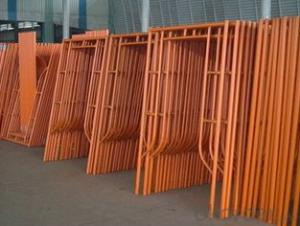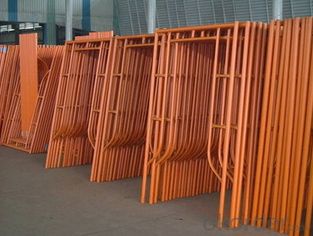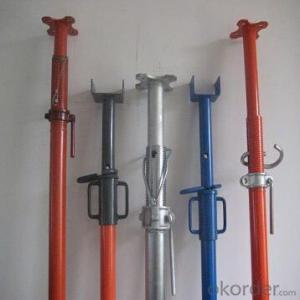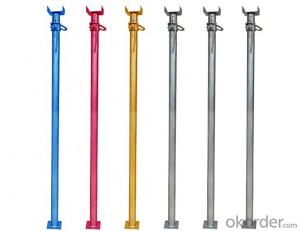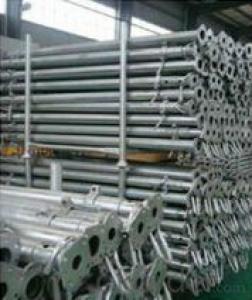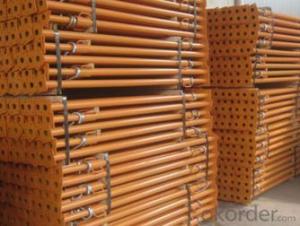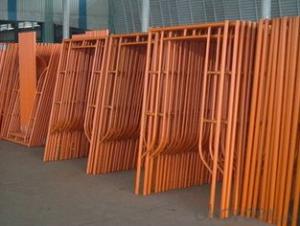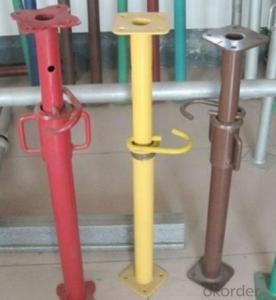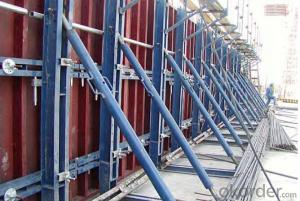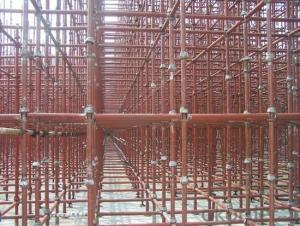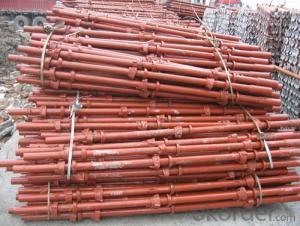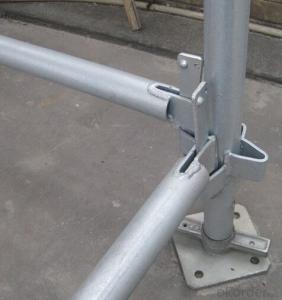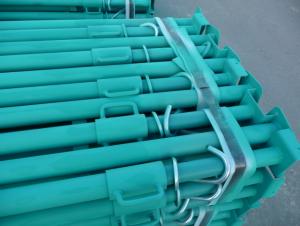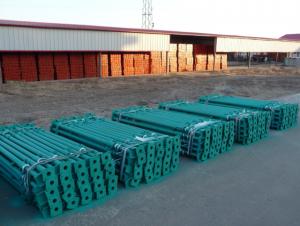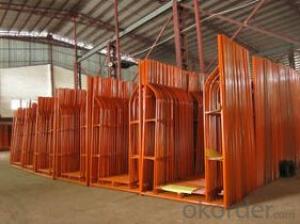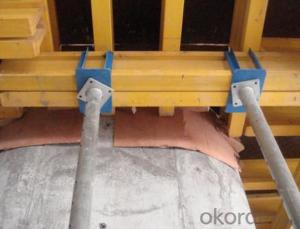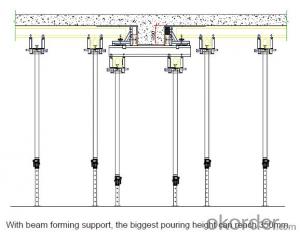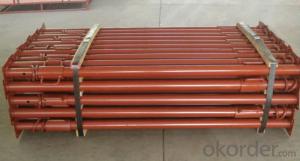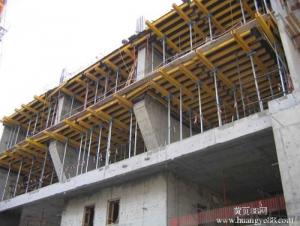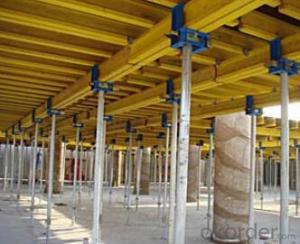Steel Frame Scaffolding H Frame Scaffolding For Sale (Frame Types of Scaffolding)
- Loading Port:
- China Main Port
- Payment Terms:
- TT OR LC
- Min Order Qty:
- -
- Supply Capability:
- -
OKorder Service Pledge
OKorder Financial Service
You Might Also Like
Quick Details
| name: | material: | thickness: | |||
| surface Treament: | standard: |
Packaging & Delivery
| Packaging Detail: | CARTONS THEN ON PALLET,OR AS YOUR REQUEST. |
| Delivery Detail: | WITH IN 25 DAYS |
Specifications
1. Reliable performance
2. Corrosion resistance
3. Durable finish standards
Steel Frame Scaffolding H Frame Scaffolding For Sale
1. Product Information
Product Name | Steel Frame Scaffolding H Frame Scaffolding For Sale |
Type | GTJ-F014 |
Material | Q235 |
Thickness | 1.6mm to3mm or as your requirements |
Surface Treatment | Galvanized, DIP Painting, Powder coated |
color | Customised, normally we make it red(Dark red and Farrari red), yellow, green, blue and silver. |
Dimension | Light duty 40-48mm, MID Duty 48-56/58mm, Heavy duty 48-60mm |
MOQ | 10tons |
Product feature | anti-rust, high breaking strength |
Packaging & Delivery
1.Suitable qty in one carton box
2.Suitable qty packed in plastic bags, then to platte or tray.
3.20 to 25pcs in woven bags
4.20GP can be loaded about 23 to 26 tons
5.deliverying time is about 20days to 30days
- Q: Can steel props be used in formwork systems?
- Yes, steel props can be used in formwork systems. Steel props are commonly used to support temporary structures and formwork systems during construction projects. They provide stability and strength to the formwork and can be easily adjusted to the desired height. Steel props are favored due to their durability and load-bearing capacity, making them suitable for various formwork applications.
- Q: Are there any alternatives to using steel props in construction?
- Yes, there are alternatives to using steel props in construction. Some of these alternatives include adjustable telescopic props made from aluminum or fiberglass, modular support systems using lightweight materials like timber or plastic, and hydraulic or pneumatic shoring systems. These alternatives offer advantages such as reduced weight, easier handling, corrosion resistance, and increased flexibility in terms of adjusting height and load capacities.
- Q: Can steel props be used for supporting temporary roofs?
- Indeed, temporary roofs can be supported using steel props. Acrow props, also referred to as adjustable steel props, are frequently employed in construction endeavors for the purpose of providing temporary support to various structures. Their height adjustability renders them perfectly suitable for supporting temporary roofs of varying dimensions and configurations. The robust and long-lasting characteristics of steel props guarantee their ability to withstand the weight and maintain stability of the roof structure. Furthermore, the installation and removal of steel props can be accomplished with ease, thus rendering them a practical and effective solution for temporary roof support.
- Q: Can steel props be used for supporting temporary bridges over roadways?
- Temporary bridges over roadways can be supported using steel props. These props, also referred to as temporary supports or shoring, are frequently utilized in construction projects to provide temporary support to structures like bridges, scaffolding, and formwork. Made from robust and long-lasting steel, they are well-suited to bear heavy loads, including those of temporary bridges. Steel props are easily adjustable in terms of height and can withstand the weight and forces exerted by vehicles passing over the temporary bridge. Furthermore, their installation and removal are quick and efficient, making them an appropriate option for supporting temporary bridges.
- Q: Can steel props be used for temporary support during tank installation?
- Yes, steel props can be used for temporary support during tank installation. Steel props are commonly used in construction to provide temporary support to structures, such as walls, ceilings, and floors. They are adjustable in height and can be easily installed and removed, making them ideal for temporary applications. When installing a tank, steel props can be used to provide additional support to ensure the tank is stable and secure during the installation process. However, it is important to ensure that the steel props are properly designed and installed by professionals to ensure the safety of the installation process.
- Q: What are the maintenance requirements for a steel prop?
- The maintenance requirements for a steel prop primarily involve regular cleaning and inspection. To ensure optimal performance and longevity, it is important to keep the propeller free from debris, saltwater, and other contaminants. Regularly washing the propeller with fresh water after each use and using a mild detergent can help remove any dirt or salt buildup. Inspecting the propeller for any signs of damage, such as dents, cracks, or bent blades, is also crucial. If any damage is detected, it should be promptly addressed by a professional technician or propeller repair specialist to prevent further issues and potential failure. Additionally, it is recommended to lubricate the propeller shaft periodically to minimize friction and wear. Using a marine-grade grease or lubricant can help protect the propeller against corrosion and ensure smooth operation. Lastly, it is essential to follow the manufacturer's guidelines and recommendations for maintenance and servicing. Different steel propellers may have specific care instructions, and adhering to these guidelines will help maintain the propeller's performance and integrity. Regular professional inspections and services are also recommended to ensure any underlying issues are identified and resolved efficiently.
- Q: How do you ensure proper bracing of steel props?
- Proper bracing of steel props can be ensured by following a few key steps. Firstly, it is important to accurately calculate the required number of props and their spacing based on the load-bearing capacity and the dimensions of the structure. Secondly, props should be positioned vertically and aligned properly to ensure their stability. Additionally, the use of adjustable props allows for precise adjustments and leveling. Lastly, diagonal bracing should be installed to provide lateral support and prevent any potential buckling or collapse. Regular inspections and maintenance are also crucial to identify any signs of damage or weakness and address them promptly.
- Q: Can steel props be used in the construction of airports?
- Yes, steel props can be used in the construction of airports. Steel props, also known as adjustable steel props or scaffolding props, are commonly used in construction to support various structures, including temporary formwork, walls, slabs, and beams. In the case of airport construction, steel props can be used to support the formwork for concrete structures such as airport terminals, hangars, control towers, and other buildings. Steel props are highly versatile and can be easily adjusted to different heights, making them suitable for various construction applications. They provide sturdy support and stability during the construction process, ensuring the safety and integrity of the structures being built. Additionally, steel props are durable and can withstand heavy loads, making them suitable for the construction of large-scale airport projects. Furthermore, steel props are relatively easy to assemble and disassemble, which allows for efficient construction processes. They can be quickly installed and adjusted to the required height, saving time and labor costs. Steel props are also reusable, making them a cost-effective solution for airport construction projects. Overall, steel props are a valuable tool in the construction industry and can be effectively used in the construction of airports. They provide reliable support, durability, and flexibility, contributing to the successful completion of airport infrastructure projects.
- Q: Can steel props be used for temporary support during column installation?
- Yes, steel props can be used for temporary support during column installation. Steel props are commonly used in construction projects to provide temporary support to structures, including columns, during installation or other stages of construction. They are adjustable and can bear heavy loads, making them suitable for providing temporary support until the permanent structure is in place.
- Q: How do steel props withstand lateral forces?
- Steel props, also known as steel shoring or steel shores, are structural supports used in construction to temporarily hold or brace a structure. They are designed to withstand various forces, including lateral forces. Steel props are typically made of high-strength steel, which provides them with the necessary rigidity and strength to withstand lateral forces. The props are designed with a tubular shape, which helps distribute the forces evenly along their length. To enhance their resistance to lateral forces, steel props are often equipped with adjustable features. These features allow the props to be securely tightened against a structure, providing additional stability and preventing movement caused by lateral forces. Furthermore, steel props can be interconnected and braced together, creating a system that enhances their overall resistance to lateral forces. This system of interconnected props forms a stable framework that can distribute and resist lateral forces more effectively. In addition to their structural design, steel props can also be reinforced with additional bracing elements, such as diagonal struts or cross braces. These elements further enhance the props' ability to withstand lateral forces by adding extra support and stability to the structure. Overall, steel props are specifically engineered to withstand lateral forces by combining high-strength steel construction, adjustable features, interconnection, and additional bracing elements. This ensures that they provide the necessary support and stability to safely withstand the lateral forces encountered during construction or temporary shoring applications.
Send your message to us
Steel Frame Scaffolding H Frame Scaffolding For Sale (Frame Types of Scaffolding)
- Loading Port:
- China Main Port
- Payment Terms:
- TT OR LC
- Min Order Qty:
- -
- Supply Capability:
- -
OKorder Service Pledge
OKorder Financial Service
Similar products
Hot products
Hot Searches
Related keywords
